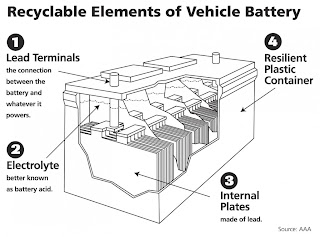Car batteries are highly recyclable - AAAEnlarge Photo
A concern raised over upcoming electric-drive cars--the all-electric 2011 Nissan Leaf, the 2011 Chevrolet Volt, and the 2012 Toyota Prius Plug-In Hybrid--is what happens to their lithium-ion battery packs once the car's life ends.

Images of those battery packs tossed over cliffs or littering roadsides are a little overblown. Even after its automotive life is over, a used lithium-ion pack retains most of its energy capacity.
Most analysts expect a secondary market for used batteries to arise late in the 2010s. For instance, packs might become energy accumulators for photovoltaic solar panels or wind turbines, meaning renewable electricity could be generated, stored and used locally.
But, worry the naysayers, won't that require a huge infrastructure to accumulate, value, and redistribute these used packs?
Well, yes. But there's a very good model in place already: It's how we handle today's conventional 12-Volt lead-acid starter batteries, the ones used in almost every single one of the 70 million or so motor vehicles built globally each year.
Turns out that the 12-Volt battery is the most recycled product in the world, according to the U.S. Environmental Protection Agency. In the U.S. alone, about 100 million auto batteries a year are replaced, and 99 percent of them (p. 9) are turned in for recycling.
Roughly 97 percent of the lead in a 12-Volt battery can be recycled. The electrolyte, especially sulfuric acid, can be neutralized, repurposed, or converted into sodium sulfate used in fertilizers or dyes. Even the plastic case can be ground up and reused.
The one fly in the ointment? That recycling isn't always done properly. The Blacksmith Institute calls the incorrect dismantling of lead-acid batteries one of its 10 worst pollution problems for the globe.
Meanwhile, Toyota--which has sold two-thirds of the world's hybrid cars--has procedures in place for its dealers to properly dispose of used nickel-metal-hydride battery packs from cars like its Prius.
Lithium-ion packs just started to make their way into new cars last year--the first in the world was the 2009 Mercedes-Benz S400 Hybrid--but we expect other automakers to do the same.
One bonus: While lead is a highly neurotoxic substance (the Mad Hatter was so named, for instance, because he was poisoned by the lead used in making felt hats), most lithium-ion battery packs are essentially non-toxic.
So until you end up driving--and then junking--an electric car, be sure to recycle your auto battery as soon as you replace it.
Almost every place that you can buy a new battery will take the old one back for recycling. In fact, you may have to pay a "core charge" if you don't turn in the used battery.
A concern raised over upcoming electric-drive cars--the all-electric 2011 Nissan Leaf, the 2011 Chevrolet Volt, and the 2012 Toyota Prius Plug-In Hybrid--is what happens to their lithium-ion battery packs once the car's life ends.

Images of those battery packs tossed over cliffs or littering roadsides are a little overblown. Even after its automotive life is over, a used lithium-ion pack retains most of its energy capacity.
SURVEY
Most analysts expect a secondary market for used batteries to arise late in the 2010s. For instance, packs might become energy accumulators for photovoltaic solar panels or wind turbines, meaning renewable electricity could be generated, stored and used locally.
But, worry the naysayers, won't that require a huge infrastructure to accumulate, value, and redistribute these used packs?
Well, yes. But there's a very good model in place already: It's how we handle today's conventional 12-Volt lead-acid starter batteries, the ones used in almost every single one of the 70 million or so motor vehicles built globally each year.
Turns out that the 12-Volt battery is the most recycled product in the world, according to the U.S. Environmental Protection Agency. In the U.S. alone, about 100 million auto batteries a year are replaced, and 99 percent of them (p. 9) are turned in for recycling.
Roughly 97 percent of the lead in a 12-Volt battery can be recycled. The electrolyte, especially sulfuric acid, can be neutralized, repurposed, or converted into sodium sulfate used in fertilizers or dyes. Even the plastic case can be ground up and reused.
The one fly in the ointment? That recycling isn't always done properly. The Blacksmith Institute calls the incorrect dismantling of lead-acid batteries one of its 10 worst pollution problems for the globe.
Meanwhile, Toyota--which has sold two-thirds of the world's hybrid cars--has procedures in place for its dealers to properly dispose of used nickel-metal-hydride battery packs from cars like its Prius.
Lithium-ion packs just started to make their way into new cars last year--the first in the world was the 2009 Mercedes-Benz S400 Hybrid--but we expect other automakers to do the same.
One bonus: While lead is a highly neurotoxic substance (the Mad Hatter was so named, for instance, because he was poisoned by the lead used in making felt hats), most lithium-ion battery packs are essentially non-toxic.
So until you end up driving--and then junking--an electric car, be sure to recycle your auto battery as soon as you replace it.
Almost every place that you can buy a new battery will take the old one back for recycling. In fact, you may have to pay a "core charge" if you don't turn in the used battery.
1 comment:
very nice blog, i really liked it In the event that you are unsure of the status of your car battery, make sure to talk about it with
your aid counsel.
Post a Comment